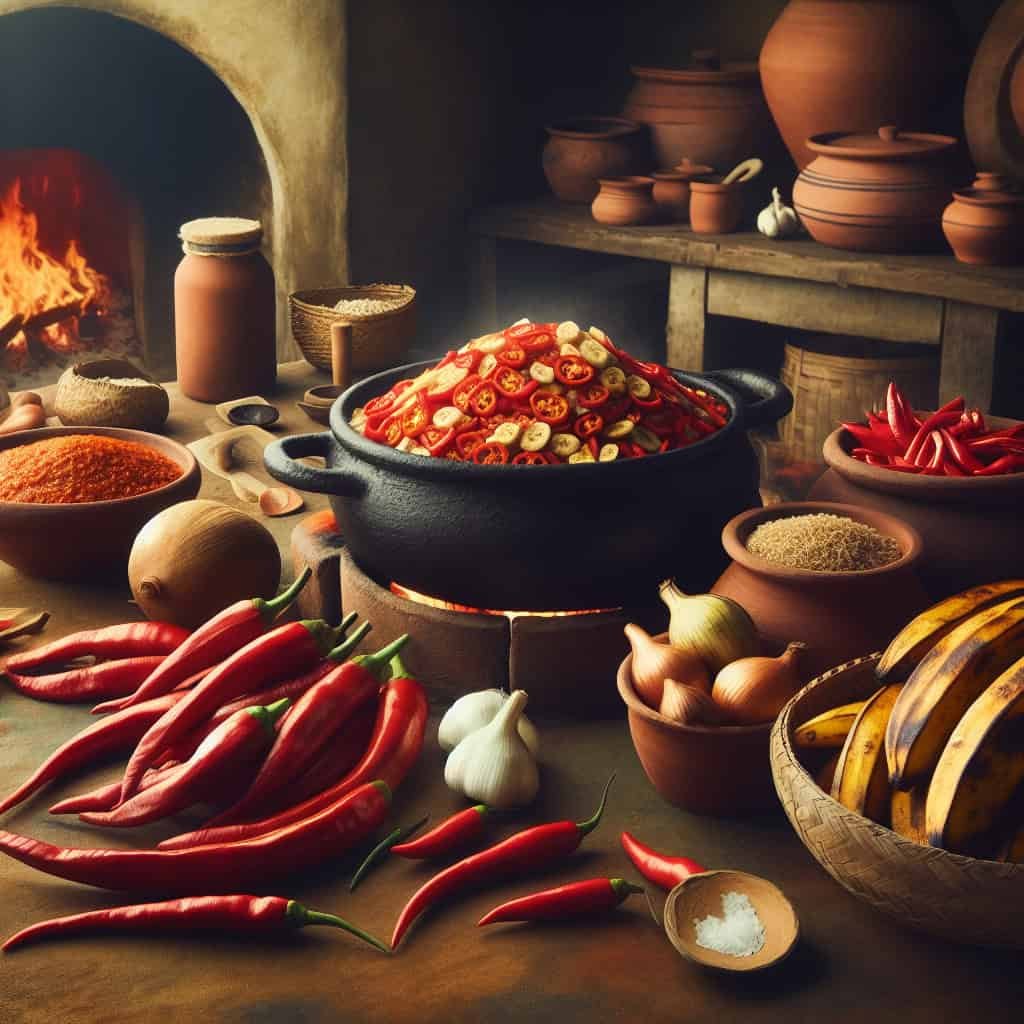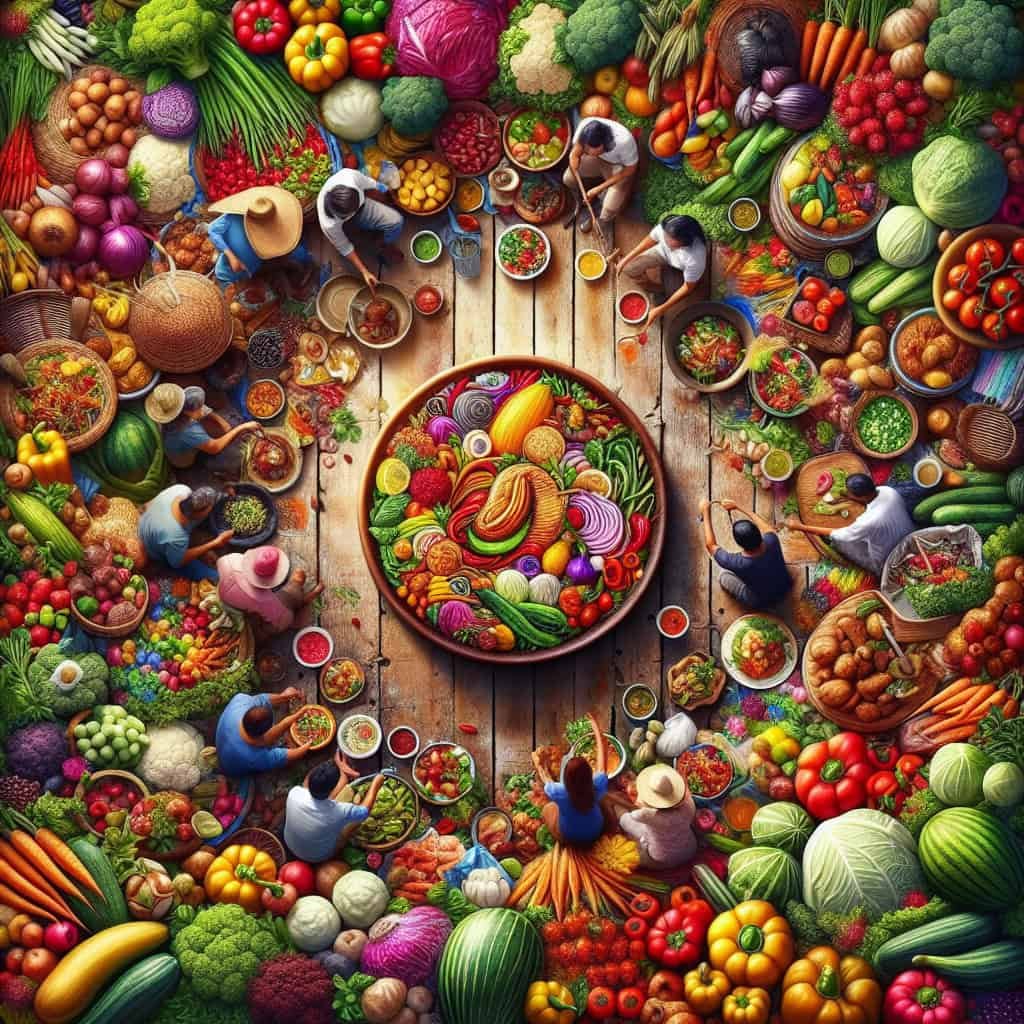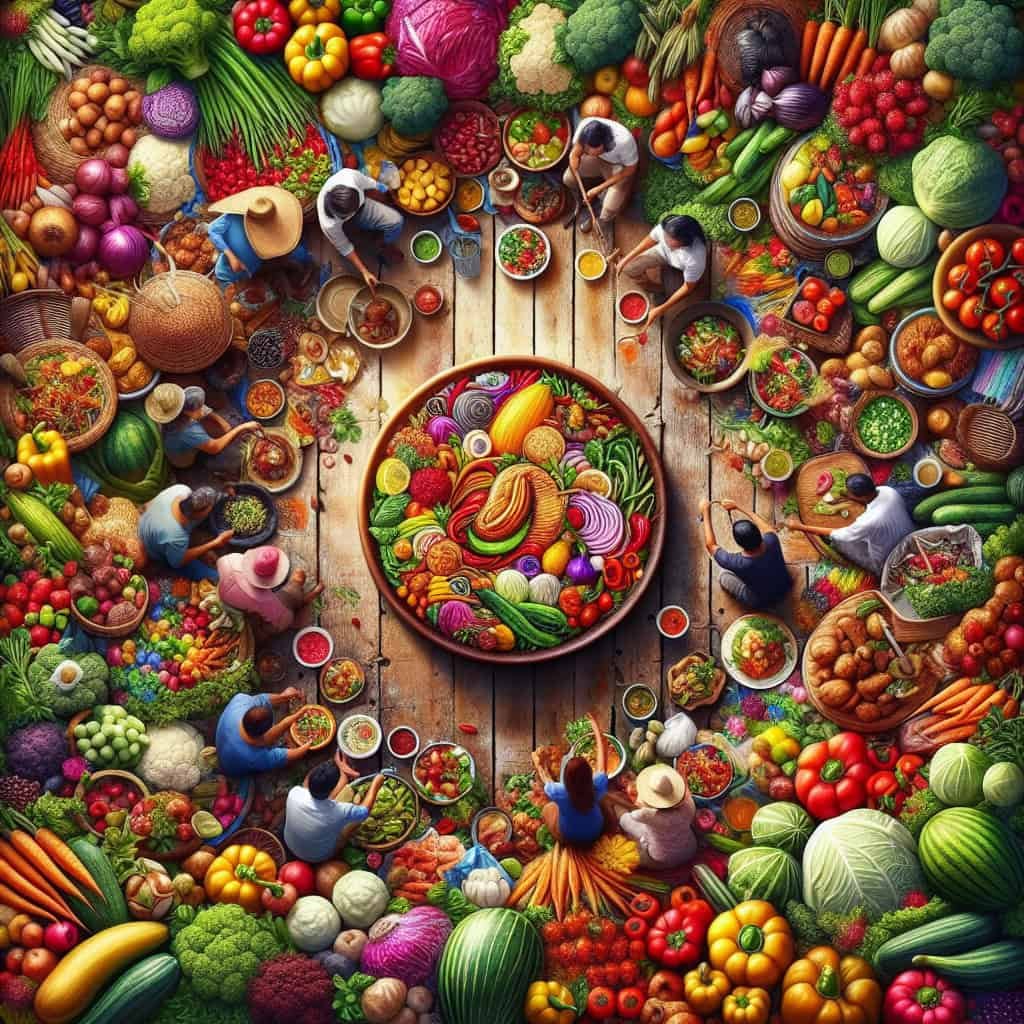Nicaraguan cuisine is a flavorful fusion of indigenous traditions and Spanish influences. From the world-renowned gallo pinto to the mouthwatering vigorón, the typical ingredients used in Nicaraguan dishes are a true reflection of the country’s diverse landscape and rich culinary history. With ingredients sourced from both land and sea, Nicaraguan cuisine incorporates staples such as rice, beans, corn, plantains, fresh seafood, and an array of aromatic herbs and spices. Join us on a tantalizing journey as we explore the vibrant flavors and origins behind the ingredients that make Nicaraguan cuisine so unique and delicious.

Fruits and Vegetables
Nicaraguan cuisine incorporates a wide variety of fresh fruits and vegetables, lending vibrant flavors to its dishes. Plantains, for example, are a staple in Nicaraguan cooking. These starchy fruits are often used in dishes like maduros, where they are fried until golden and caramelized. They add a delightful sweetness and satisfying texture to the meal. Yucca, another common ingredient, is a root vegetable known for its versatility. Whether boiled, fried, or mashed, yucca adds a hearty element to many traditional dishes.
Beans and corn, both essential to Nicaraguan cuisine, are locally sourced and play a crucial role in meals. Beans, such as red beans or black beans, are commonly used in dishes like gallo pinto, a beloved Nicaraguan rice and beans dish. The corn used in Nicaraguan cuisine is typically white or yellow and can be found in various forms, including masa for making tortillas or cornmeal for typical corn-based Nicaraguan snacks.
Tomatoes and avocado are also prevalent in Nicaraguan cuisine. Tomatoes add a refreshing juiciness to salads, salsas, and stews, while avocados contribute a creamy texture and rich flavor to dishes like guacamole or enjoyed sliced on top of rice and beans. Jicama, a root vegetable with a crisp texture and slightly sweet taste, is often added to salads or consumed as a refreshing snack. Squash, particularly in its winter form, known as Ayote, is utilized in soups and stews, adding a comforting and earthy component.
Papaya and mango, both popular tropical fruits in Nicaragua, provide a burst of sweetness to the cuisine. Papaya is often enjoyed fresh or used in fruit salads, while mangoes are commonly found in desserts, smoothies, and even savory dishes, lending a vibrant and tropical flair.
Meats and Seafood
When it comes to meats and seafood, Nicaraguan cuisine offers various options to satisfy different palates. Beef is widely consumed and can be found in dishes such as carne asada, where grilled or roasted beef is marinated in flavorful seasonings. Pork is also prevalent, often used in dishes like chicharrones, which are crispy fried pork rinds. Chicken, a versatile protein, is utilized in countless dishes, ranging from soups to grilled or stewed preparations.
Being a country rich in lakes and coastline, fish is a popular choice for seafood lovers. Nicaragua offers a range of fish varieties, including tilapia, which can be grilled, fried, or used in stews. Lobster and shrimp are considered delicacies and are commonly found in coastal regions, prepared in various ways, from grilled to sautéed to added to flavorful seafood stews.
Ceviche, a dish consisting of raw fish or seafood marinated in citrus juices, is a refreshing and popular option. It is typically enjoyed as an appetizer or light meal. Chorizo, a flavorful sausage often made with pork, is used in dishes like chorizo con yuca, where it is served alongside yucca.
For adventurous eaters, cuy (guinea pig) is a unique meat option that can be found in some traditional Nicaraguan dishes. Although not as common as other meats, cuy is celebrated in certain regions and offers a distinct taste experience.
Herbs and Spices
Herbs and spices are essential in Nicaraguan cuisine, adding depth and complexity to dishes. Cilantro, a fragrant and flavorful herb, is commonly used as a garnish or ingredient. It enhances the taste of soups, stews, and salsas, providing a fresh and vibrant touch. Achiote, a bright red seed derived from the annatto tree, is used as a natural coloring agent and imparts a mild earthy flavor to various dishes.
Cumin, with its warm and earthy notes, is a staple spice in Nicaraguan cooking. It can be found in meat marinades, rice dishes, and spice blends. Garlic, a culinary powerhouse, is widely used for its aromatic and savory qualities. Oregano, whether fresh or dried, adds a fragrant and slightly bitter taste to many Nicaraguan dishes.
Onions, both red and white, are fundamental ingredients in Nicaraguan cuisine. They provide a savory base for many recipes, lending their distinctive taste to soups, stews, and sautés. Bay leaves, with their subtle herbal flavor, are often added to stews, rice dishes, and bean preparations.
Chili peppers, such as jalapeños or habaneros, add fiery heat to Nicaraguan cuisine. They can be used fresh, dried, or in powdered form, depending on the desired level of spiciness. Parsley, another versatile herb, offers a fresh and slightly peppery taste, often used for garnishing dishes or enhancing the flavor of seafood.
Annatto, derived from the achiote tree, is an ingredient that not only provides vibrant color but also imparts a mild flavor. It can be found in various forms, such as powder or oil, and is frequently used in Nicaraguan cuisine to add depth and a hint of earthiness to dishes.
Condiments and Sauces
Condiments and sauces are essential components of Nicaraguan cuisine, adding flavor and enhancing dishes. Salsa Lizano, a popular condiment in Nicaragua, is a tangy and slightly sweet sauce that can be found on tables across the country. It is often used as a topping for rice and beans, grilled meats, or to add a kick to dishes like gallo pinto.
Chimichurri, originally from Argentina, has also found its place in Nicaraguan cuisine. This herbaceous sauce, made with parsley, garlic, vinegar, and oil, adds a burst of freshness and tanginess to grilled meats.
Encurtidos, which are pickled vegetables, are a common accompaniment to many meals in Nicaragua. They offer a crunchy and zesty contrast to the flavors of the main dish. Nacatamal sauce, specifically used for the traditional Nicaraguan tamale known as nacatamal, is a rich and savory sauce made with spices, onions, garlic, and tomatoes.
Sour cream and mayonnaise are frequently used as toppings and spreads in Nicaraguan cuisine. They provide a creamy and tangy element to dishes, whether used in sandwiches, as a dip, or as a garnish. Tajadas, thinly sliced and fried plantains, are often served with sour cream or mayonnaise, creating a delectable combination of flavors and textures.
Guacamole, a delightful blend of mashed avocados, tomatoes, onions, and spices, is a classic Nicaraguan condiment. It is commonly enjoyed with tortilla chips or used as a topping for various dishes. Mashed beans, made from simmered and mashed beans, offer a creamy and flavorful side dish or spread.
Curtido, a fermented cabbage slaw, is a popular accompaniment in Nicaraguan cuisine. It adds a tangy and slightly spicy crunch to dishes, such as pupusas or grilled meats. The combination of flavors and textures creates a harmonious balance that complements many traditional Nicaraguan meals.

Grains and Starches
Grains and starches are foundational elements in Nicaraguan cuisine, providing nourishment and serving as the basis for many traditional dishes. Rice, a staple in the Nicaraguan diet, is often cooked with onions, garlic, and sometimes vegetables or spices, such as annatto, to add flavor and color. It accompanies numerous Nicaraguan dishes and serves as a foundation for rice and beans.
Tortillas, made from corn or flour, are a versatile component of Nicaraguan cuisine. They can be enjoyed on their own, used to wrap various fillings, or served alongside main dishes. Tostones, made from green plantains that are sliced, fried, smashed, and fried again, offer a crispy and savory alternative to tortillas. They are commonly enjoyed as a side dish or used as a base for toppings.
Yucca fries provide a delicious and satisfying starch option. These crispy and golden fries, made from yucca root, are a flavorful accompaniment to many traditional Nicaraguan meals. Gallo Pinto, a beloved rice and beans dish, combines the two staples into a comforting and hearty meal that is often enjoyed for breakfast.
Tamales, traditionally made with masa, are a cherished Nicaraguan dish. These steamed pockets of corn dough filled with various ingredients are a labor of love and often enjoyed during special occasions. Cornmeal, used in Nicaraguan cuisine, serves as the base for dishes like rosquillas, a popular cornmeal-based cookie or snack.
Churros, a sweet treat made from a dough of flour and water, are deep-fried and coated in sugar. They are a beloved snack that pairs well with coffee or hot chocolate. Pupusas, originating from El Salvador but widely enjoyed in Nicaragua, are thick corn tortillas filled with cheese, beans, meat, or vegetables. They are often served with curtido, adding a delightful crunch and tangy flavor.
Cachapitas, a corn-based dish similar to a pancake, are often enjoyed as a breakfast or brunch option. They are made with fresh corn kernels, cornmeal, and spices, offering a unique and savory flavor.
Dairy Products
Dairy products are not as prevalent in Nicaraguan cuisine as other ingredients, but they still play a role in certain dishes and desserts. Quesillo, a type of soft cheese wrapped in banana leaves, is a Nicaraguan specialty. It is enjoyed on its own or used as a filling for dishes like quesillo tortillas or tacos. Cheese, both locally produced and imported, is used in various savory dishes to add richness and creaminess.
Crema, a thick and tangy sour cream, is a popular accompaniment to many Nicaraguan dishes. It can be used as a topping for soups, stews, or drizzled over roasted meats. Queso Seco, a dry and salty cheese, adds a strong and savory flavor to dishes.
Leche Agria, or sour milk, is used in some traditional Nicaraguan recipes, lending a tart and tangy taste. Nicaraguan ice cream, often made with ingredients like coconut or tropical fruits, provides a refreshing and indulgent treat.
Leche Condensada, or sweetened condensed milk, is a common ingredient in Nicaraguan desserts, including tres leches cake, where it contributes to the rich and moist texture. Buñuelos, a deep-fried dough often coated in sugar or syrup, are a beloved Nicaraguan dessert that can be enjoyed on special occasions.
Leche Poleada, a creamy vanilla custard, is often used as a topping or filling in desserts like cakes or pastries. Cajeta, a thick and sweet caramel made from goat’s milk, is another delightful addition to Nicaraguan desserts.

Beverages
Beverages in Nicaraguan cuisine are diverse and offer a range of options to quench one’s thirst. Coffee holds a special place in Nicaraguan culture and is known for its bright and distinctive flavor. It is often enjoyed black or with a touch of sugar, providing a rich and aromatic experience.
Rum, a staple in many Latin American countries, including Nicaragua, is often enjoyed neat or used as a base for refreshing cocktails. It adds warmth and depth to various beverages, imparting a distinct flavor profile.
Tiste, a traditional Nicaraguan drink, is made from toasted corn kernels, cocoa, and spices. It is often consumed chilled, offering a unique and refreshing taste. Pinolillo, another traditional beverage, is made from ground roasted corn, cacao, and spices. It can be enjoyed hot or cold, providing a comforting and slightly sweet flavor.
Cacao, derived from raw cocoa beans, is consumed in Nicaragua in various forms. Whether enjoyed as a hot chocolate drink or incorporated into desserts, it adds a rich and chocolaty taste. Refresco, meaning fruit juice or fruit punch, is popular in Nicaragua, where a variety of fruits are blended with water or milk to create refreshing and vibrant beverages.
Chicha, a fermented corn-based drink, is traditionally sweetened and served during festivities or celebrations. Chia Fresca, made from chia seeds soaked in water or juice, offers a unique and refreshing texture while providing hydration.
Tecojote, derived from the tecojote fruit, is a popular drink in Nicaragua, known for its invigorating properties and slightly sweet flavor. Horchata, made from rice, milk, cinnamon, and sugar, is a creamy and spiced beverage enjoyed cold.
Nuts and Seeds
Nuts and seeds are not as broadly utilized in Nicaraguan cuisine, but they still make appearances in certain dishes and beverages. Peanuts, commonly found in Nicaragua, are often roasted and consumed as a snack or used as an ingredient in recipes.
Cashews, native to Central America, provide a rich and buttery flavor. They are sometimes enjoyed on their own or used as a topping or mix-in for dishes like salads or stir-fries. Sesame seeds, small but mighty, are used to garnish dishes and add a subtle nuttiness.
Pumpkin seeds, or pepitas, are commonly enjoyed as a snack or used as a topping for dishes like salads or soups. Chia seeds, known for their nutritional benefits, are soaked in water or juice to create a gel-like texture that can be enjoyed on its own or added to smoothies or desserts.
Drinks with a nut or seed base, such as horchata or pinolillo, provide a delightful and slightly creamy texture that complements the other flavors in the beverages. Nuts and seed snacks, often roasted and seasoned with spices, offer a crunchy and satisfying option.
Tigre Tonka, a rare and exotic seed, is sometimes used in Nicaraguan cuisine to add a unique flavor to desserts or beverages. María Luisa seed, derived from the María Luisa flower, is used as an herb for infusions or to enhance the flavor of certain dishes.
Jocote, a small fruit native to Central America, is often enjoyed fresh or used in various Nicaraguan recipes. It provides a tangy and slightly sweet taste, contributing to the vibrant flavors of Nicaraguan cuisine.

Sweeteners
Sweet treats hold a special place in Nicaraguan cuisine, and various sweeteners are used to create indulgent desserts and confections. Sugar, both cane and granulated, is commonly utilized to add sweetness to countless Nicaraguan dishes and beverages.
Honey, whether locally sourced or imported, acts as a natural sweetener and offers a distinct floral flavor. It can be used in desserts, sauces, or even as a drizzle over fruits or bread.
Panela, also known as piloncillo or rapadura, is unrefined cane sugar molded into cones or blocks. It is used to sweeten dishes, imparting a rich and caramel-like taste. Dulce de Leche, made by slowly cooking sweetened condensed milk until it thickens and caramelizes, is a luscious and velvety sweetener used in many Nicaraguan desserts.
Guava Paste, made from guava fruit and often rolled in sugar, is a popular sweet addition. It is enjoyed on its own or incorporated into desserts, providing a delightful burst of tropical flavor. Tres Leches Cake, a moist and decadent dessert, is soaked in a mixture of three types of milk—evaporated milk, sweetened condensed milk, and heavy cream.
Sweetened Condensed Milk, a rich and sweet dairy product, is widely used in Nicaraguan sweet preparations. It contributes to the creamy and sweet nature of desserts like flan or tres leches cake. Turron, a traditional Spanish nougat made with almonds, honey, and sugar, is sometimes enjoyed as a sweet treat in Nicaragua.
Caña de Azúcar, or sugarcane, is used in Nicaragua not only as a sweetener but also as a snack. Sugarcane sticks can be found sold by street vendors, offering a naturally sweet and fibrous treat. Marshmallow, although not as widely utilized in traditional Nicaraguan cuisine, is occasionally used in desserts or as a topping for drinks, adding a fluffy and sweet element.
Other Ingredients
Nicaraguan cuisine incorporates various other ingredients that contribute diverse flavors and textures to dishes. Eggs, a versatile ingredient, can be found in both sweet and savory dishes. They are used in recipes like gallo pinto or as a binding agent in desserts like flan.
Vinegar, typically made from sugarcane or fruit, adds tanginess and acidity to many Nicaraguan recipes. It is commonly used in marinades, dressings, or as a condiment. Coconut milk, extracted from grated coconut flesh, is used in certain Nicaraguan dishes to add a creamy and tropical element. It is often found in soups, stews, or desserts.
Banana leaves, a versatile and traditional wrapping material, are used for cooking and serving various dishes. They impart a unique flavor and aroma to foods, while also providing a natural and sustainable method of cooking. Tamarind, a fruit with a tangy and slightly sweet taste, is used as a natural flavoring agent in certain dishes and beverages.
Breadfruit, an intriguing fruit resembling a large, spiky green bread roll, is enjoyed roasted, boiled, or mashed. It has a starchy texture and mild flavor, often used as a substitute for potatoes or other root vegetables. Chelemite, also known as jocote de corona, is a small fruit with a tart taste. It is used in certain dishes, or enjoyed fresh or pickled as a snack.
Piloncillo, known as panela in other Latin American countries, is unrefined whole cane sugar that has been boiled and solidified into cone or block-shaped forms. It is used in many Nicaraguan desserts and sweet preparations, adding depth and a hint of molasses flavor. Nopal cactus, also as a popular ingredient in Mexican cuisine, can be found in some Nicaraguan recipes. It offers a unique texture and taste, often used in salads or stews.
Cocoa butter, derived from cocoa beans, is used in Nicaraguan cuisine for its rich and smooth flavor. It is utilized in desserts and confections, adding a luxurious taste and creamy texture.
In conclusion, Nicaraguan cuisine celebrates a wide range of ingredients sourced from its fertile lands and vibrant waters. From the tropical fruits and vegetables that infuse dishes with freshness and vibrancy to the diverse array of meats and seafood that cater to different palates, Nicaraguan cuisine offers a delightful and varied culinary journey. The herbs, spices, and condiments add depth and complexity, while grains, dairy products, and sweeteners contribute to the comforting and indulgent nature of the cuisine. With its unique combination of flavors and textures, Nicaraguan cuisine is a true reflection of the country’s rich culinary heritage and cultural diversity.

